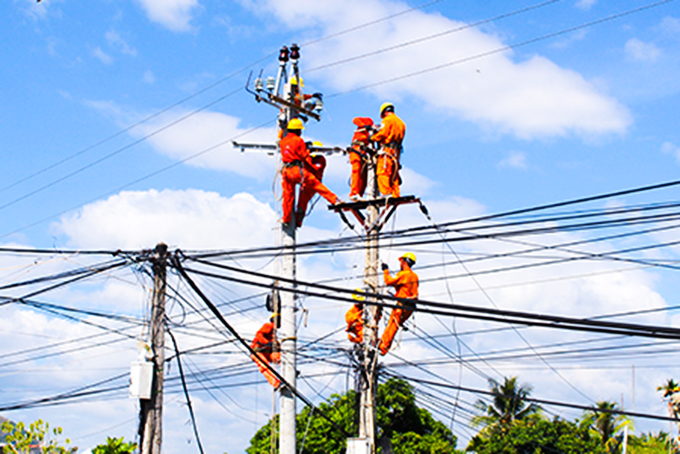
The Standing Committee of Khanh Hoa Provincial Party Committee has just drafted a plan to deploy the implementation of Resolution No. 55-NQ/TW of the Politburo on the orientation of the National Energy Development Strategy to 2030, with a vision to 2045 in the province.
The Standing Committee of Khanh Hoa Provincial Party Committee has just drafted a plan to deploy the implementation of Resolution No. 55-NQ/TW of the Politburo on the orientation of the National Energy Development Strategy to 2030, with a vision to 2045 in the province. In particular, renewable energy sources will be given priority.
Many energy development goals
The draft is built with the aim of ensuring energy security, providing adequate, stable and good quality energy at reasonable prices for the sustainable socio-economic development, ensuring national defense and security activities, improving people's living, and contributing to protecting ecological environment. In addtion, the draft aims to efficiently exploit and use rational energy resources, thoroughly practicing thrifty and efficient use of energy; proactively upgrade and build an advanced and modern transmission and distribution grid, giving priority to developing rational power sources.
Specifically, the province will coordinate and complete plannings of power source and power grid in the province to provide sufficient energy demand, meeting socio-economic development goals and national security for 10 years (2021 - 2030), heading to 2045. In particular, the province will meet the total demand for electricity capacity of about 1,380MW by 2030, around 3,450MW by 2045, with a total electricity consumption of about 7.4 billion kWh by 2030; about 22 billion kWh by 2045. The total capacity of the locally produced power sources is expected to reach 3,220MW by 2030 and about 4,200MW by 2045.
In the draft, the Provincial Party Standing Committee prioritizes the development of renewable energy sources for electricity production; increases the proportion of electricity produced from renewable energy sources. The proportion of renewable energy sources in the total energy source will reach about 45% in 2030, 55% in 2045. At the same time, the province will build grid system which is intelligent, efficient, flexible, highly automated from transmission to distribution, and capable of connecting the region. Safe power supply will be ensured, reliability standards and safe and continuous electricity supply. The rate of energy saving on the total energy consumption compared to the normal development scenario will reach about 4% in 2030 (of which electricity saving reaches 2%) and about 10% by 2045.

|
To develop many sources of energy supply
Right after the draft was built, the provincial People's Committee has deployed it to departments and branches for comments. Ms. Le Thu Hai - Director of the Department of Industry and Trade said that in order to comment on the draft Plan for the implementation of Resolution No. 55 of the Politburo, the Department has sent the document to the localities and related units to request feedback. Most units agreed with the content built into the draft. The department bases on the provincial electricity development plan for the period 2016 - 2025, with a vision to 2035 approved by the Ministry of Industry and Trade and practically implemented in recent years to set energy development goals in the province. Specifically, the electricity industry will meet the total demand for electricity capacity of about 1,380 MW by 2030, and about 3,450MW by 2045. The total electricity consumption will be around 7.4 billion kWh by 2030, and about 22 billion kWh by 2045. Among them, the total capacity of on-site power sources will reach about 3,220MW by 2030 and around 4,200MW by 2045.
According to the leaders of the Department of Industry and Trade, over the past time, the electricity generation in the province is mainly renewable energy from 3 hydroelectric plants, 2 power plants, 6 solar power plants. Actual capacity of power plants is increasing year by year. The figure in 2017 was only 120 MW, ncreased to 127 MW in 2018 and to 340 MW in 2019. In the coming time, Sumitomo thermal power plant with a capacity of 1,320MW and other solar power plants going into operation will create abundant energy sources, meeting the energy needs for socio-economic development in the province.
The province aims to develop primary energy sources in the future in the direction of increasing autonomy; encouraging and promoting the strong development of renewable energy sources in order to maximize the replacement of fossil energy sources; prioritizing the use of geothermal, wind and solar energy for electricity generation; encouraging investment in the construction of power plants using municipal waste, biomass and solid waste in parallel with environmental protection and economic development; creating favorable conditions for the electricity industry to invest in modernization from production, transmission to distribution; improving the capacity of ensuring electricity network security and quality of electricity services; and actively implementing programs on demand management, consumption intensity and power loss reduction.
Dinh Lam
Translated by T.T




